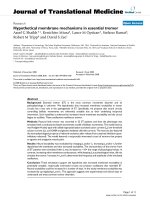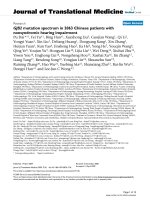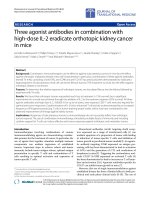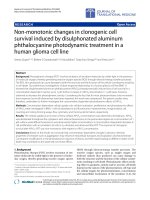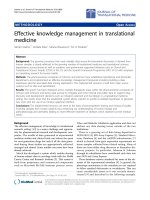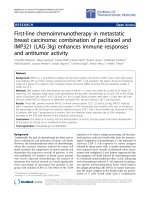báo cáo hóa học:" Femoral tunnel placement in anterior cruciate ligament reconstruction: rationale of the two incision technique" docx
Bạn đang xem bản rút gọn của tài liệu. Xem và tải ngay bản đầy đủ của tài liệu tại đây (645.82 KB, 6 trang )
BioMed Central
Page 1 of 6
(page number not for citation purposes)
Journal of Orthopaedic Surgery and
Research
Open Access
Technical Note
Femoral tunnel placement in anterior cruciate ligament
reconstruction: rationale of the two incision technique
Raffaele Garofalo
1,2
, Biagio Moretti
1
, Cyril Kombot
2
, Lorenzo Moretti
1
and
Elyazid Mouhsine*
2
Address:
1
Department of clinical methodology and surgical technique, orthopaedics section, University of Bari, Bari, Italy and
2
Department of
traumatology and orthopaedic surgery, University Hospital, Lausanne, Swizerland
Email: Raffaele Garofalo - ; Biagio Moretti - ;
Cyril Kombot - ; Lorenzo Moretti - ;
Elyazid Mouhsine* -
* Corresponding author
Abstract
Endoscopic anterior cruciate ligament (ACL) reconstruction can be performed through one-
incision or two-incision technique. The current one-incision endoscopic ACL single bundle
reconstruction techniques attempt to perform an isometric repair placing the graft along the roof
of the intercondylar notch, anterior and superior to the native ACL insertion. However the ACL
isometry is a theoretical condition, and has not stood up to detailed testing and investigation.
Moreover this type of reconstruction results in a vertically oriented non-anatomic graft, which is
able to control anterior tibial translation but not the rotational component of the instability.
Femoral tunnel obliquity has a great effect on rotational stability. To improve the obliquity of graft,
an anatomical ACL reconstruction should be attempt. Anatomical insertion of ACL on the femur
lies very low in the notch, spreading between 11 and 9–8 o'clock position and the center lies lower
than at 11 o'clock position. Femoral aiming devices through the tibial tunnel aim at an isometric
placement, and they do not aim at an anatomic position of the graft. Also, a placement of tunnel in
a position of 11 o'clock is unable to restore rotational stability. The two-incision technique, with
the possibility to position femoral tunnel independently by tibial tunnel, allows us to place femoral
tunnel entrance in a position of 10 'clock that can most accurately reproduce the anatomic
behaviour of the ACL and can potentially improve the response of the graft to rotatory loads. This
positioning results in a more oblique graft placement, avoiding problem related to PCL
impingement during knee flexion. Further studies are required to understand if this kind of
reconstruction can ameliorate proprioception as well as clinical outcome at a long-term follow-up.
Background
Endoscopic anterior cruciate ligament (ACL) reconstruc-
tion is a surgery that allows most subjects to resume activ-
ity at preinjury level. However the estimated failure rate
after this surgery remains approximately 10% [1]. For
many years the two-incision technique has represented
the gold standard operation for ACL reconstruction [2,3].
In the last years, however, the single incision tibial endo-
scopic technique has been developed to obviate the neces-
Published: 21 May 2007
Journal of Orthopaedic Surgery and Research 2007, 2:10 doi:10.1186/1749-799X-2-10
Received: 20 October 2006
Accepted: 21 May 2007
This article is available from: />© 2007 Garofalo et al; licensee BioMed Central Ltd.
This is an Open Access article distributed under the terms of the Creative Commons Attribution License ( />),
which permits unrestricted use, distribution, and reproduction in any medium, provided the original work is properly cited.
Journal of Orthopaedic Surgery and Research 2007, 2:10 />Page 2 of 6
(page number not for citation purposes)
sity of the lateral incision and to, potentially, reduce
operative time and surgical morbidity.
Many published reports have concluded that there is no
difference in subjective, objective, functional, or radio-
graphic mid-terms follow-up outcomes between one or
two incision technique [4,5]. However, these studies have
not compared the obliquity of femoral tunnels, but now-
adays we know that placement of femoral tunnel has a
great influence on knee kinematics [6,7]. Transtibial ACL
reconstruction has shown some disadvantages in the fem-
oral tunnel placement with respect to the two incision
techniques. With transtibial technique, in particular, fem-
oral tunnel can not be placed freely, so this technique dic-
tates a relatively vertical and central non anatomical graft
placement compared to the more horizontal and lateral
course of the native ACL. This physiometric "central cruci-
ate" cannot control rotational stability and places abnor-
mal force on the knee joint, which could lead to
degenerative osteoarthritis in long term [6-8]. To obviate
the above problems, drilling femoral tunnel through
anteromedial portal has been proposed. With the knee in
a maximally flexed position, it seems to be possible to per-
form a femoral tunnel 5 mm anterior to the posterior cap-
sular insertion through this portal at the 11 o'clock (right)
or 1 o'clock position with respect to the apex of the notch
[9]. Also the graft placed in this position failed to control
rotatotial stability [7]. Recently, a great number of sur-
geons sustaining the one-incision transtibial reconstruc-
tion technique has focused the attention on the double
bundle (DB) anatomical reconstruction of the ACL to
ameliorate the rotational control on the reconstructed
knee [10].
Moreover there are other recognized potential pitfalls of
the endoscopic technique, including graft tunnel mis-
match [11], interference screw fixation divergence [12] or
screw laceration of the graft, posterior cruciate ligament
(PCL) impingement [13] and possible violation of poste-
rior cortical wall [5]. The purpose of this paper is first, to
describe anatomical single bundle ACL reconstruction
with a two-incision technique and second, to discuss the
rationale of this technique by reviewing anatomy and bio-
mechanics on femoral tunnel position in ACL reconstruc-
tion.
Surgical technique
Setup and graft harvesting
The patient is placed in the supine position with a lateral
post just proximal to the knee. In our mind graft choices
in primary ACL reconstruction for young persons and
sports people is the bone-patellar tendon-bone (BPTB)
graft, whereas semitendinosus and gracilis tendons (ST-
GR) is reserved for older subjects, women, and those
devoted to recreational sports or for patients with some
patellar problems.
BPTB is harvested via an incision of 7 cm in average,
extending from the inferior pole of patella to the tibial
tubercle. The paratenon is divided longitudinally. A cen-
tral third bone-patella tendon-bone (BPTB) graft is har-
vested 10 mm wide with 10 or 11-mm × 25-mm tibial
bone block and 9 or 10-mm × 20-mm patellar bone block.
The block is cut in a trapezoidal fashion at the tibial level
and in a triangular fashion at the level of patella to reduce
bone stress and anterior knee pain. A small rongeur and a
graft shaper are used to trim the graft to the appropriate
size. One hole is drilled in each bone block to be used for
leading threads. Normally, tibial bone plug is positioned
into femoral tunnel and patellar bone plug into the tibial
tunnel. A number 2 reabsorbable suture is passed through
these holes and used as pulling suture. The tibial bone-
tendon junction is marked with a sterile pen to aid in
appropriate placement within the femoral tunnel.
Before starting arthroscopic step of reconstruction, patel-
lar tendon defect is closed with a 3.0 reabsorbable suture.
We prefer to include the Hoffa tissue in the first proximal
stitch. Paratenon is closed with a running suture.
In case in whom we use hamstring tendon the ST-GR ten-
dons are harvested through a 2–3 cm oblique incision
made directly over the pes anserinus in line with the ham-
string tendons course. Once the sartorius fascia is identi-
fied, it is opened and an angled clamp is then used to
localize the ST-GR tendon, which is harvested with an
open tendon stripper with the limb held in the so-called
figure-of-four position. Retained muscle belly is scraped
from the tendons and the end of each graft is then sutured
for approximately 4 cm with a "Chinese" finger trap stitch
of a number 2 nonabsorbable suture. The quadrupled ten-
don graft is sutured at the looped end using one stitch of
a number 1 absorbable suture. The graft is sized and a
mark is made at 30 mm from the looped end.
Arthroscopic reconstruction
We use a high anterolateral and low anteromedial portal
for arthroscopy. A outflow portal is made through the
suprapatellar pouch to end in the medial gutter. Articular
and meniscal injury are addressed at first. Any remaining
fibres of the ruptured ACL are debrided using scissor and
motorized 5.5 mm full radius resector. A 10 mm curved
rugine is used to debride the medial wall of the lateral
condyle just to the posterior capsule so as to identify the
site of insertion of native ACL. The same instrument is
used to verify that the distance between PCL (posterior
cruciate ligament) and medial wall of lateral condyle is at
least 10 mm. If it not the case a lateral trochleoplasty is
performed.
Journal of Orthopaedic Surgery and Research 2007, 2:10 />Page 3 of 6
(page number not for citation purposes)
With the knee flexed at an average of 90 degree, a specific
femoral drill guide (Phusis- Grenoble- France) is inserted
through the anteromedial portal (Fig. 1). The tip of the
guide is placed immediately behind the footprint of
native ACL. The landmarks for a correct placement of
guide are the passage between the notch roof and lateral
notch wall, and the superior border of cartilage of the pos-
terior part of the lateral femoral condyle. The identifica-
tion of these key points allows us to place femoral tunnel
at 10 o'clock (2 o'clock) at level of native ACL (Fig. 2). The
external arm of the femoral guide lies outside on the lat-
eral femoral condyle. A lateral skin incision of an average
of 2 cm is made slightly superior to the lateral epicondyle.
This incision passed longitudinally through the anterior
portion of iliotibial band and is straight to the bone (Fig
3). The guide pin is drilled with a slight oblique direction
from back to front and from high to low. An outside-in
femoral tunnel of 25 to 30 mm long is established with a
cannulated reamer with the diameter identical to the graft.
The completed tunnel should have almost no bone in the
back edge with the most anterior edge positioned at the
level of the isometric point (Fig. 4). The tibial tunnel is
created using a 55 degree drilling guide introduced
through the anteromedial portal. The tip of the guide is
placed slightly medial to the centre of the intercondylar
region, 7 mm anterior to the PCL, on a line joining the
inner edge of the anterior horn of the lateral meniscus and
the medial tibial spine. Drilling is performed in the anter-
omedial tibia. After the guide pin is placed in a right posi-
tion, it is overdrilled with a cannulated drill. The size of
drill is identical to graft size.
With a suture passer, the graft can be passed into the knee
by passing a nylon loop-shuttle suture through the joint.
The suture at the end of graft is passed in the loop suture,
so the surgeon pulling on the loop suture out of tibial or
femoral tunnel, allowing the suture of the graft to go out
the tunnel.
Hamstring tendon graft is positioned such that the mark
at 30 mm is flushed with the femoral tunnel, whether
BPTB is positioned such that the marked tendon-bone
junction is flushed with the intra-articular entrance of the
femoral tunnel. BPTB is passed with the cortical surface
posterior to keep the tendinous portion of the graft as pos-
terior as possible. Different systems of fixation can be
used. Anyway femoral fixation is performed at first. A
Picture of external view of guide placement on the lateral side of distal part of a right thighFigure 3
Picture of external view of guide placement on the lateral
side of distal part of a right thigh. A little skin incision neces-
sary to perform this technique is showed.
Photograph of the specific rigid femoral drill guide used to create the outside-in femoral tunnelFigure 1
Photograph of the specific rigid femoral drill guide used to
create the outside-in femoral tunnel.
Arthroscopic view of a right knee showing the tip of femoral guide placed in the ACL anatomical footprint lower than roof of the intercondylar notchFigure 2
Arthroscopic view of a right knee showing the tip of femoral
guide placed in the ACL anatomical footprint lower than roof
of the intercondylar notch.
Journal of Orthopaedic Surgery and Research 2007, 2:10 />Page 4 of 6
(page number not for citation purposes)
maximal manual tension is applied to the distal sutures of
the graft and the knee is cycled through full flexion exten-
sion several times for graft pretensioning and settling. The
knee is placed in approximately 30 degree of flexion, with
one arm of assistant put under the proximal femur, and
tibial fixation is carried-out under arthroscopic control. At
the end of procedure, the scope is inserted retrograde in
the tibial tunnel to verify that during passive knee motion
there is no graft motion.
Rationale of the two incision ACL reconstruction
The native ACL lies in an oblique position with a complex
attachment to the femur [14]. This attachment is smaller
than tibial, and is semicircular (18 × 10 mm) with a
straight anterior border and a convex posterior border. It
lies at level of posteromedial wall of the lateral femoral
condyle, at the transition between the notch roof a bone
cartilage boundary of the posterior part of the lateral fem-
oral condyle. The attachment extends anteriorly 6 to 8
mm from the posterior border which gives the footprint a
rounded triangular shape [15,16]. The ACL has a complex
anatomy. Many investigators [16,17] have described ana-
tomically separated fibre bundles of the ACL. Based on
their tibial attachments, the bundles are called anterome-
dial (AM) and posterolateral (PL) bundles, some also
includes an intermediate bundle [18]. At level of femur,
the attachment of AM bundle is anterior and proximal,
just behind the top of the intercondylar notch roof. This
point is corresponding to the most isometric point
[19,20]. Consequently, the most anterior fibers of AM
bundle are the most isometric [21,22]. The reason of plac-
ing femoral bone tunnel at 11:00 o'clock position for a
right knee and 1:00 o'clock for a left knee is related to an
attempt to reconstruct the anteromedial bundle. The PL
bundle of the ACL represents the bulk of ligament and its
fibres are the most posterior and distal and provide stabil-
ity when the knee is near extension. The femoral attach-
ment site is more important than the tibial attachment
because it has a greater effect on the graft length changes
as the knee flexes and extends, [21]. In fact, the center of
rotation is closer to the femoral attachment than the tibial
attachment side, so there is little room for error when
placing the femoral tunnel. Clinical results correlate posi-
tively with femoral tunnels placed at least 60% posterior
to the anterior origin of Blumensaat line in a deep and
superior (proximal) position [23].
A cadaveric study, performed by Arnold et al., has con-
firmed that the anatomical insertion of ACL on the femur
lies very low in the notch spreading between 11 and 9–8
o'clock and the center lies lower than at 11 o'clock posi-
tion [14]. The major part of these fibres lies posteriorly to
the isometric point on the medial wall of the femoral con-
dyle [24]. These fibres located behind the most isometric
point, are lax during flexion and tight in extension. Cham-
bat has defined the behaviour of these fibres as "favoura-
ble non isometry" [25]. During knee extension we can
observe a progressive recruitment of the fibres from front
(the most isometric) to backward. The "favourable non
isometry" is very interesting because knee loading during
daily activities occurs at flexion angles of less than 60
degrees, and to reproduce it, an anatomical placement of
the graft should be performed during surgery.
The major part of current endoscopic transtibial ACL
reconstruction techniques place the graft along the roof of
the intercondylar notch, anterior and superior to the
native ACL insertion, exposing some of fibers of the non-
anatomically placed graft to higher strain rates and risk of
failure. Some authors sustaining that a nearly isometric
behaviour of the ACL substitute is desirable, with a maxi-
mum of 2–3 mm lengthening of the graft towards exten-
sion [18,26]. The isometry is widely influenced by
femoral tunnel placement. Studies evaluating isometric
placement of graft have suggested that the 12-o'clock posi-
tion with a 2 mm of posterior wall was the most isometric
[27], but this position results in a vertically oriented non-
anatomic graft [28]. In such situation the anterior stability
of the knee is partially controlled, but rotational stability
remained uncontrolled, resulting in a persistent pivot
shift with consequent pathologic knee kinematics that can
be associated with a poorer outcome and long-term arthri-
tis [6,8,29]. Hefzy et al. [21] noted a larger isometric (2
mm) zone superiorly and proximally, so most authors are
recommending an entry point high in the notch, at the 11
o'clock position for a right knee with 1 to 2 mm posterior
cortical shell, and often this requires the use of a more
Arthroscopic nomenclature viewing the knee in the sagittal plane, with anatomical nomenclature in parenthesesFigure 4
Arthroscopic nomenclature viewing the knee in the sagittal
plane, with anatomical nomenclature in parentheses. The cir-
cle indicates the site of femoral tunnel to positioning anatom-
ical single bundle reconstruction where the most anterior
point of tunnel correspond to isometric point of AM bundle.
Journal of Orthopaedic Surgery and Research 2007, 2:10 />Page 5 of 6
(page number not for citation purposes)
inferior anteromedial portal resulting in a more demand-
ing technique [30]. However, the current method used to
place the femoral tunnel in the 11 o'clock position seems
to be inaccurate and moreover analysis of literature shows
that the ACL isometry is a theoretical condition, and has
not stood up to detailed testing and investigation
[22,26,27].
According to cadaveric dissection [14], we create a 25 to
30 mm long femoral tunnel at anatomical insertion site of
all, at 10 o'clock position. This positioning is impossible
to obtain through a transtibial endoscopic technique [14].
To reach a better femoral tunnel placement the anterome-
dial portal instead of the transtibial portal with a knee
flexed at 130 degrees has been proposed [9]. Moreover,
problem about PCL impingement when using transtibial
technique should not be ignored. Simmons et al. [13]
have showed that placing the femoral tunnel in the coro-
nal plane at 60 degree lowers graft tension in flexion. This
minimize PCL impingement of graft. To obtain this posi-
tioning with the transtibial technique, a special tibial
guide should be used and drilling through the superficial
fibers of the medial collateral ligament should be per-
formed [13].
The rationale to perform an anatomical ACL reconstruc-
tion is also related to concept of rotational stability.
Recent study has shown that placing ACL graft at the 11
o'clock is unable to restore rotational stability [31]. Loh et
al [6] in a laboratory robotic study reproduced a single
bundle ACL reconstruction positioning the femoral tun-
nel at 10 and 11 o'clock. They found that the 10 o'clock
femoral position restored anterior tibial translation and in
situ forces towards knee extension significantly better than
the 11 o'clock position, and although the resulting knee
kinematics was not normal, however, the rotational knee
stability was improved. Scopp [7], using a biomechanical
model, has shown that reconstructing the femoral tunnel
at the oblique anatomic origin of the native ACL, oriented
60 degrees from vertical, more closely restored knee rota-
tional stability than the standard tunnel reconstruction
oriented at 30 degrees from vertical [7]. This positioning
corresponds to our proposed technique of ACL recon-
struction with a "favourable non isometry" [25] and to
place the graft in this area, a femoral tunnel at 10 o'clock
position on the right lateral femoral condyle should be
drilled, with the knee at 90 degrees of flexion.
Recently, the group of surgeon sustaining the one-incision
reconstruction technique has shift the attention on the DB
ACL reconstruction in attempt to ameliorate the rota-
tional control on the reconstructed knee [32].
Nevertheless, it should be underlined that rotational con-
trol of knee is not completely related to ACL. Other
peripheral restraints are also responsible for this control,
otherwise we could not explain why different people with
a complete, subacute ACL disruption show different
grades of pivot shift phenomenon. Probably a certain
number of ACL disruption are not isolated. However, the
evaluation and diagnosis of peripheral associated instabil-
ity, such as anterolateral rotatory instability is demanding
and difficult to assess objectively, so the associated lesions
often are not addressed with a consequent persistence of a
some rotational instability, that probably could remain
using a DB ACL reconstruction.
In our opinion DB ACL reconstruction is a shift of empha-
sis to an anatomic procedure. Nevertheless, creation of
three or four tunnels is technically challenging and some
concerns such as theoretical risks of avascular necrosis of
the lateral femoral condyle, fracture, graft impingement
and difficulty in revision cases should be taken in account.
Moreover further clinical trials will be necessary to deter-
mine whether these theoretical advantages will translate
into superior clinical outcomes.
For instance, according to other authors [28,33,34], ana-
tomical single bundle reconstruction using a two-incision
technique seems to be a good technique to position fem-
oral tunnel entrance in a position that most accurately
reproduces an anatomic behaviour of the ACL and poten-
tially can improve the response of the graft to rotational
loads.
Further biomechanical studies in "vivo" are needed to ver-
ify if this positioning of femoral tunnel have some posi-
tive effects on long-terms clinical outcome in terms of
reduction of pivot shift phenomenon and improved pro-
prioception.
References
1. Williams RJ 3rd, Hyman J, Petrigliano F, Rozental T, Wickiewicz TL:
Anterior cruciate ligament reconstruction with a four-
strand hamstring tendon autograft. J Bone Joint Surg Am 2004,
86:225-232.
2. Bach BR Jr: Arthroscopy assisted patellar tendon substitution
for anterior cruciate ligament reconstruction. Am J Knee Surg
1989, 2:3-20.
3. Buss DD, Warren RF, Wickiewicz TL, Galinat BJ, Panariello R:
Arthroscopically assisted reconstruction of the anterior cru-
ciate ligament with use of autogenous patellar-ligament
grafts. Results after twenty-four to forty-two months. J Bone
Joint Surg Am 1993, 75(9):1346-55.
4. Arciero RA, Scoville CS, Snyder RJ, Taylor DC, Huggard DJ: Single
versus two-incision arthroscopic anterior cruciate ligament
reconstruction. Arthroscopy 1996, 12(4):462-9.
5. Sgaglione NA, Schwartz RE: Arthroscopically assisted recon-
struction of the anterior cruciate ligament: initial clinical
experience and minimal 2-year follow-up comparing endo-
scopic transtibial and two-incision techniques. Arthroscopy
1997, 13(2):156-65.
6. Loh JC, Fukuda Y, Tsuda E, Steadman RJ, Fu FH, Woo SL: Knee sta-
bility and graft function following anterior cruciate ligament
reconstruction: Comparison between 11 o'clock and 10
o'clock femoral tunnel placement. Arthroscopy 2003,
19(3):297-304.
Publish with BioMed Central and every
scientist can read your work free of charge
"BioMed Central will be the most significant development for
disseminating the results of biomedical research in our lifetime."
Sir Paul Nurse, Cancer Research UK
Your research papers will be:
available free of charge to the entire biomedical community
peer reviewed and published immediately upon acceptance
cited in PubMed and archived on PubMed Central
yours — you keep the copyright
Submit your manuscript here:
/>BioMedcentral
Journal of Orthopaedic Surgery and Research 2007, 2:10 />Page 6 of 6
(page number not for citation purposes)
7. Scopp JM, Jasper LE, Belkoff SM, Moorman CT 3rd: The effect of
oblique femoral tunnel placement on rotational constraint
of the knee reconstructed using patellar tendon autografts.
Arthroscopy 2004, 20(3):294-9.
8. Tashman S, Collon D, Anderson K, Kolovwich P, Anderst W: Abnor-
mal rotational knee motion during running after anterior
cruciate ligament reconstruction. Am J Sports Med 2004,
32(4):975-83.
9. Webb JM, Corry IS, Clingeleffer AJ, Pinczewski LA: Endoscopic
reconstruction for isolated anterior cruciate ligament rup-
ture. J Bone Joint Surg Br 1998, 80(2):288-94.
10. Zelle BA, Brucker PU, Feng MT, Fu FH: Anatomical double-bun-
dle anterior cruciate ligament reconstruction. Sports Med
2006, 36(2):99-108.
11. Denti M, Bigoni M, Randelli P, Monteleone M, Cevenini A, Ghezzi A,
Schiavonne Panni A, Trevisan C: Graft-tunnel mismatch in endo-
scopic anterior cruciate ligament reconstruction. Intraoper-
ative and cadaver measurement of the intra-articular graft
length and the length of the patellar tendon. Knee Surg Sports
Traumatol Arthrosc 1998, 6(3):165-8.
12. Fanelli GC, Desai BM, Cummings PD: Divergent alignment of the
femoral interference screw in single incision endoscopic
reconstruction of the anterior cruciate ligament. Contemp
Ortho 1994, 28:21-25.
13. Simmons R, Howell SM, Hull ML: Effect of the angle of the femo-
ral and tibial tunnels in the coronal plane and incremental
excision of the posterior cruciate ligament on tension of an
anterior cruciate ligament graft: an in vitro study. J Bone Joint
Surg Am 2003, 85-A(6):1018-2.
14. Arnold MP, Kooloos J, van Kampen A: Single-incision technique
misses the anatomical femoral anterior cruciate ligament
insertion: a cadaver study. Knee Surg Sports Traumatol Arthrosc
2001, 9(4):194-9.
15. Amis AA, Jacob RP: Anterior cruciate ligament graft position-
ing, tensioning and twisting. Knee Surg Sports Traumatol Arthrosc
1998, 6(suppl 1):2-12.
16. Girgis FG, Marshall JL, Monajem A: The cruciate ligaments of the
knee joint. Anatomical, functional and experimental analy-
sis. Clin Orthop 1975, 106:216-31.
17. Hole RL, Lintner DM, Kamaric E, Moseley JB: Increased tibial
translation after partial sectioning of the anterior cruciate
ligament. The posterolateral bundle. Am J Sports Med 1996,
24(4):556-60.
18. Amis AA, Dawkins GP: Functional anatomy of the anterior cru-
ciate ligament. Fibre bundle actions related to ligament
replacements and injuries. J Bone Joint Surg Br 1991, 73(2):260-7.
19. Furia JP, Lintner DM, Saiz P, Kohl HW, Noble P: Isometry meas-
urements in the knee with the anterior cruciate ligament
intact, sectioned, and reconstructed. Am J Sports Med 1997,
25(3):346-52.
20. Noyes FR, Butler DL, Grood ES, Zernicke RF, Hefzy MS: Biome-
chanical analysis of human ligament grafts used in knee-liga-
ment repairs and reconstructions. J Bone Joint Surg Am 1984,
66(3):344-52.
21. Hefzy MS, Grood ES, Noyes FR: Factors affecting the region of
most isometric femoral attachments. Part II: The anterior
cruciate ligament. Am J Sports Med 1989, 17(2):208-16.
22. Gill TJ, Steadman JR: Anterior cruciate ligament reconstruction
the two incision technique". Orthop Clin North Am 2002,
33:727-735.
23. Khalfayan EE, Sharkey PF, Alexander AH, Bruckner JD, Bynum EB:
The relationship between tunnel placement and clinical
results after anterior cruciate reconstruction. Am J Sports Med
1996, 24:335-41.
24. Giron F, Buzzi R, Aglietti P: Femoral tunnel position in anterior
cruciate ligament reconstruction using three techniques. A
cadaver study. Arthroscopy 1999, 15(7):750-6.
25. Chambat P, Selva O: Reconstruction du ligament croisè anter-
ieure par autogreffe au tendon rotulien. Forage du tunnel
fémoral de dehors en dedans. In Sociéte Francaise d'Arthroscopie
(eds) Elsevier, Paris; 1999:141-145.
26. Sapega AA, Moyer RA, Schneck C, Komalahiranya N: Testing for
isometry during reconstruction of the anterior cruciate liga-
ment. Anatomical and biomechanical considerations. J Bone
Joint Surg Am 1990, 72(2):259-67.
27. Cooper DE, Urrea L, Small J: Factors affecting isometry of endo-
scopic anterior cruciate ligament reconstruction: the effect
of guide offset and rotation. Arthroscopy 1998, 14(2):164-70.
28. Cain EL Jr, Clancy WG Jr: Anatomic endoscopic anterior cruci-
ate ligament reconstruction with patella tendon autograft.
Orthop Clin North Am 2002, 33(4):717-25.
29. Getelman MH, Friedman MJ: Revision anterior cruciate ligament
reconstruction surgery. J Am Acad Orthop Surg 1999, 7(3):189-98.
30. Knight BS, Weinhold PS, Silver WP, Chappel JD: The effect of fem-
oral tunnel position in anterior cruciate ligament recon-
struction on knee kinematic: a dynamic study. Transections of
the Orthopaedic Research Society 2005, 30:.
31. Woo SL-Y, Kanamori A, Zeminski J, Yagi M, Papageorgiou C, Fu FH:
The effectiveness of reconstruction of the anterior of the
anterior cruciate ligament with hamstrings and patellar ten-
don. J Bone Joint Surg Am 2002, 84:907-914.
32. Zelle BA, Brucker PU, Feng MT, Fu FH: Anatomical double-bun-
dle anterior cruciate ligament reconstruction. Sports Med
2006, 36(2):99-108.
33. Gill TJ, Steadman JR: Anterior cruciate ligament reconstruction
the two incision technique. Orthop Clin North Am 2002,
33:727-735.
34. Flik KR, Bach BR: Anterior cruciate ligament reconstruction
using the two-incision arthroscopy-assisted technique with
patellar tendon autograft. Techniques in Orthopaedics 2005,
20(4):372-376.
